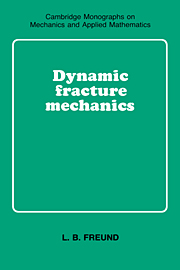Book contents
- Frontmatter
- Contents
- Preface
- List of symbols
- 1 Background and overview
- 2 Basic elastodynamic solutions for a stationary crack
- 3 Further results for a stationary crack
- 4 Asymptotic fields near a moving crack tip
- 5 Energy concepts in dynamic fracture
- 6 Elastic crack growth at constant speed
- 7 Elastic crack growth at nonuniform speed
- 8 Plasticity and rate effects during crack growth
- Bibliography
- Index
6 - Elastic crack growth at constant speed
Published online by Cambridge University Press: 03 October 2009
- Frontmatter
- Contents
- Preface
- List of symbols
- 1 Background and overview
- 2 Basic elastodynamic solutions for a stationary crack
- 3 Further results for a stationary crack
- 4 Asymptotic fields near a moving crack tip
- 5 Energy concepts in dynamic fracture
- 6 Elastic crack growth at constant speed
- 7 Elastic crack growth at nonuniform speed
- 8 Plasticity and rate effects during crack growth
- Bibliography
- Index
Summary
Introduction
The focus in this chapter, as well as in the following chapter, is on analytical models of crack growth phenomena based on nominally elastic material response. The analysis of Chapter 4 provides information on the nature of crack tip fields during rapid crack growth for several categories of material response, and parameters that characterize the strength or intensity of these fields are also identified. A main purpose in formulating and solving boundary value problems concerned with crack propagation is to determine the dependence of the crack tip field characterizing parameters on the applied loading and on the configuration of the body.
For any particular crack growth process, it is often the case that its analytical modeling can be pursued at several scales of observation. For example, consider the case of crack growth in an engineering structure. The full structure can be analyzed to determine the stress resultants that are imposed at the fracturing section. Under suitable circumstances, these stress resultants can, in turn, be viewed as the applied loads in a two-dimensional plane stress or plane strain problem from which the dynamic stress intensity factor can be determined. At a finer scale of observation, the elastic stress intensity factor represents the applied loading in an analysis of nonlinear processes very close to the crack edge. By focusing on dominant effects at adjacent levels of observation in this way, various aspects of dynamic fracture phenomena can be analyzed.
Information
- Type
- Chapter
- Information
- Dynamic Fracture Mechanics , pp. 296 - 366Publisher: Cambridge University PressPrint publication year: 1990
Accessibility standard: Unknown
Why this information is here
This section outlines the accessibility features of this content - including support for screen readers, full keyboard navigation and high-contrast display options. This may not be relevant for you.Accessibility Information
- 1
- Cited by
